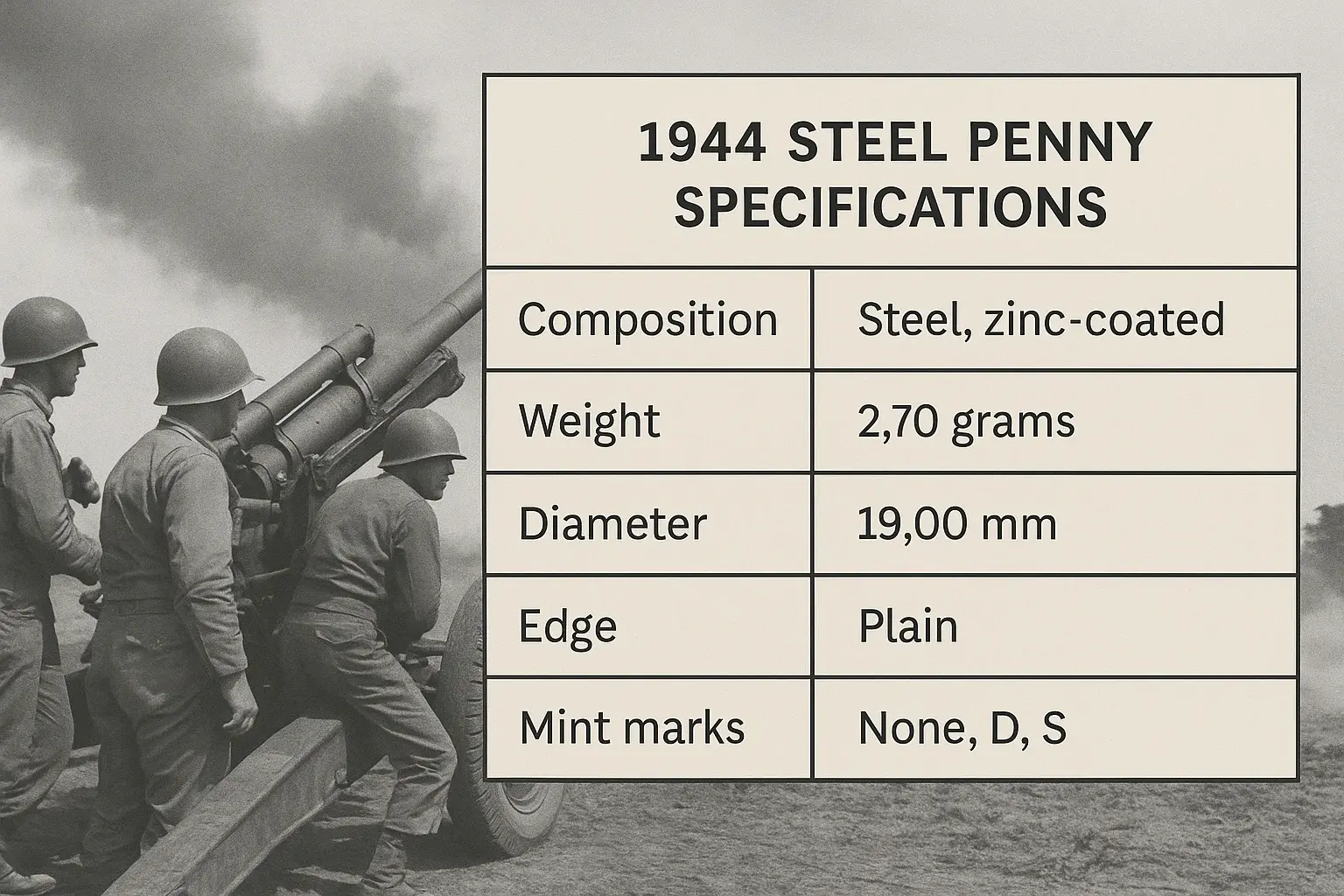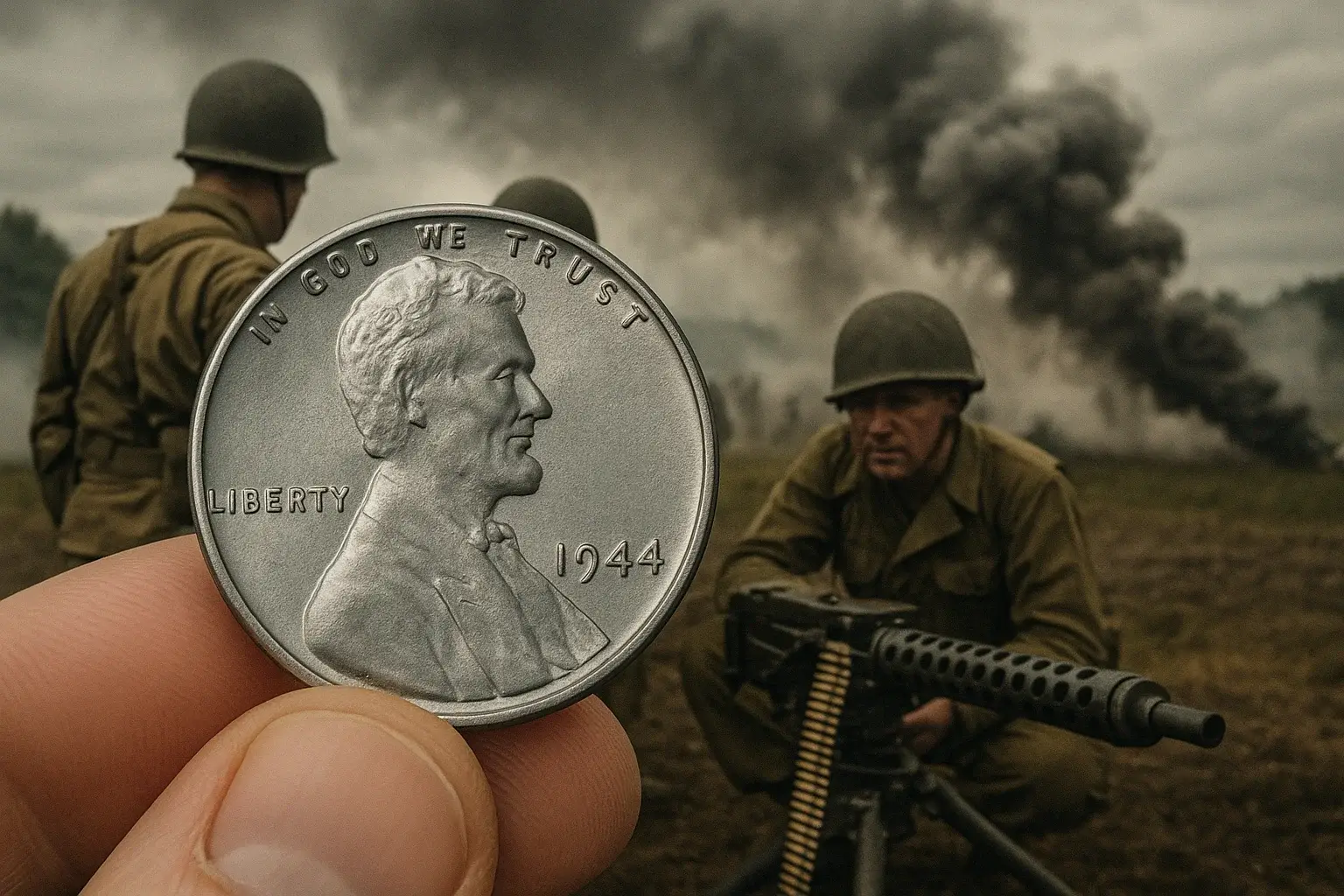The 1944 Steel Penny: History, Rarity, and Collector Value
.A 1944 steel penny is an extremely rare mint error from the Lincoln Wheat cent series.
In 1943, the U.S. Mint struck pennies from zinc-coated steel instead of copper to conserve copper for World War II ammunition and equipment. In 1944, the Mint switched back to the usual copper-alloy composition, made largely from recycled shell casings. However, a small number of leftover 1943 steel planchets (coin blanks) accidentally made their way into the presses in early 1944.
These mistakes resulted in a few genuine 1944 pennies being struck on steel instead of copper. They look similar to a 1943 steel cent—grayish in color and magnetic—but carry the 1944 date. Authentic examples are known from all three mints (Philadelphia, Denver, and San Francisco) and are considered one of the most famous U.S. coin errors.
Genuine 1944 steel penny value can be tens of thousands to over $100,000 depending on condition and certification.

History
During World War II, the United States faced severe material shortages as vast quantities of copper, nickel, and other metals were diverted to military production. Copper, in particular, was essential for making shell casings, wiring, and other wartime equipment. To conserve it, the U.S. Mint altered the composition of the one-cent coin in 1943, replacing the traditional 95% copper alloy with zinc-coated steel. These “steel cents” freed up thousands of tons of copper for the war effort, but they also caused confusion in circulation because they were similar in color to dimes and prone to rusting.
In 1944, the Mint returned to a copper-based alloy, this time using recycled brass from spent shell casings collected from military training ranges. This shift marked the end of steel-cent production—at least officially. The 1944 steel penny emerged not as a deliberate issue but as an unintended byproduct of the changeover. A few leftover 1943 steel planchets remained in the coin presses or were accidentally fed into them, creating one of the most famous and coveted error coins in U.S. history.
In the broader context of World War II numismatics, the 1944 steel penny stands alongside the 1943 bronze cent as a tangible reminder of how the war reshaped American coinage. Both coins tell a story of resource management, production urgency, and the occasional slip in a high-pressure minting environment. For collectors, they are more than just rare metal discs—they are artifacts of a pivotal moment when the Mint’s output was directly tied to the nation’s war priorities.
1944 Steel Penny Value by Grade
Mint Mark | G-4 | VG-8 | F-12 | VF-20 | EF-40 | AU-50 | MS-60 | MS-63 | MS-65 |
1944 No Mint Mark | $28,000 | $32,500 | $35,000 | $40,000 | $50,000 | $60,000 | $75,000 | $115,000 | $175,000+ |
1944-D | $30,000 | $35,000 | $40,000 | $50,000 | $60,000 | $75,000 | $90,000 | $125,000 | $200,000+ |
1944-S | $32,000 | $38,000 | $45,000 | $55,000 | $70,000 | $85,000 | $100,000 | $150,000 | $250,000+ |
G-4 to VF-20: Circulated examples with visible wear but clear date and mint mark.
EF-40 to AU-50: Lightly worn, strong details, higher eye appeal.
MS (Mint State): Uncirculated coins, with MS-65+ representing exceptional luster and strike quality.
PCGS and NGC certification is critical—uncertified coins are often viewed with suspicion due to frequent counterfeits.
Market prices for these rarities tend to rise over time because the total known population is extremely small (fewer than 30 per mint).
1944 Steel Penny Authentication Checklist
1. Check the Metal and Color
Genuine 1944 steel pennies are made from zinc-coated steel and appear grayish-silver in color.
A 1944 cent that looks coppery but is magnetic is likely a plated fake.
2. Test for Magnetism
Use a small, strong magnet.
A genuine steel penny will stick firmly to the magnet.
If it’s non-magnetic, it’s not a real 1944 steel cent.
3. Inspect the Date and Mint Mark
Look closely for signs of alteration.
Many counterfeits are made by altering a 1943 steel penny’s date to read 1944, or by plating a regular 1944 copper penny with a silvery coating.
Check for date retooling — uneven numbers, tool marks, or slightly different font shapes.
4. Weight Test
Genuine steel cents weigh about 2.70 grams.
Anything significantly heavier or lighter may be a fake or altered coin.
5. Look for Known Die Markers
Certified examples have documented die scratches, mint mark positions, and small design quirks.
Compare your coin to references in PCGS CoinFacts or NGC VarietyPlus.
6. Surface Quality
Zinc coating on genuine pieces may show slight mottling or light corrosion from age.
Fakes often have an unnaturally shiny or uniform surface from modern plating.
7. Certification Is Key
Given the rarity (fewer than 30 known per mint), professional grading by PCGS or NGC is strongly recommended before buying, selling, or insuring a coin.

Where Can I Find It?
Genuine 1944 steel pennies are so rare that you won’t find them in circulation or typical coin rolls — they almost always surface through high-end numismatic channels. The most reliable ways to find one are:
Major coin auction houses like Heritage Auctions, Stack’s Bowers, and GreatCollections, which occasionally offer certified examples.
Top-tier coin dealers who specialize in rare U.S. cents, often members of the Professional Numismatists Guild (PNG) or American Numismatic Association (ANA).
Prestigious coin shows such as the FUN Show (Florida United Numismatists) or the ANA World’s Fair of Money, where high-value rarities are displayed and sometimes for sale.
Private sales between advanced collectors, usually brokered by trusted dealers.
Given the extreme rarity and high price, any claimed 1944 steel penny should be PCGS- or NGC-certified before you consider buying. This protects you from the large number of counterfeits on the market.
Other Off-Metal Errors in U.S. Coinage History
Off-metal errors occur when a coin is struck on a planchet (blank) intended for a different denomination or composition. They are among the most dramatic and collectible U.S. minting mistakes because they combine rarity, visual appeal, and a clear break from normal production.
1943–1944 Nickel and Dime Planchet Cents – Some Lincoln cents from these years were struck on the smaller planchets intended for Jefferson nickels or Mercury dimes, often due to leftover blanks in the presses during metal changes. These coins appear slightly undersized and sometimes show incomplete designs.
1956 Cent on Silver Dime Planchet – A Lincoln cent struck on a 90% silver dime blank results in a smaller, thinner coin with reeded edges and a silvery color. The date and parts of the design are often missing near the rim.
1970-S Quarter on 40% Silver Planchet – Struck during the changeover from silver-clad to copper-nickel clad quarters, a few 1970-S Washington quarters were minted on leftover silver planchets from the previous year’s production.
Wrong Planchet Statehood Quarters (1999–2000) – Several early State Quarters were struck on planchets intended for other denominations, such as dimes, nickels, or even foreign coins. These often weigh less than normal and can exhibit incomplete rim designs.
1982 and 1983 Cents on Copper Planchets – By 1982, the U.S. Mint had switched to zinc cores with copper plating, but a few coins were struck on leftover solid copper planchets from earlier years. These weigh about 3.11 grams instead of the standard 2.5 grams for post-1982 cents.
Off-metal errors typically arise during transitional years or when multiple denominations are struck on the same press line. Because they’re easily spotted by their unusual color, size, or weight, most genuine examples are quickly identified and removed from circulation, which is why they’re so scarce today. Certified examples from PCGS or NGC often command strong premiums, especially when the date clearly ties the error to a known composition change.
Conclusion
In the numismatic market, off-metal errors such as the 1944 steel cent occupy a distinct position as both historical artifacts and high-value collectibles. Their origin is rarely accidental in the casual sense; rather, they result from transitional periods, leftover planchets, or cross-denomination production runs within the Mint’s coining facilities. The rarity of these pieces is amplified by stringent minting controls, which ensure that very few survive to enter commerce.
For serious collectors and investors, off-metal errors offer twofold appeal: they provide evidence of specific operational circumstances in U.S. minting history, and they demonstrate consistent market performance due to their limited populations and strong demand.
Proper authentication and certification by PCGS or NGC is essential, as provenance and grade have a direct impact on liquidity and realized prices at auction. When acquired from reputable sources, these coins represent not only an exceptional addition to a specialist collection but also a sound long-term numismatic asset.
